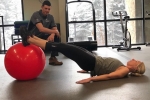What is Glute Activation?

Glute activation refers to the process of intentionally engaging and activating the gluteal muscles, specifically the gluteus maximus, gluteus medius, and gluteus minimus. These muscles are located in the buttocks and play a crucial role in various movements such as walking, running, and squatting.
Activating the glutes is important for several reasons:
-
Improved Performance: Properly activated glutes can enhance performance in various activities such as sports, weightlifting, and everyday movements.
-
Injury Prevention: Weak or inactive glute muscles can lead to compensatory movements and overuse of other muscles, increasing the risk of injury, especially in the lower back, hips, and knees.
-
Postural Support: Strong and activated glutes contribute to better posture and spinal alignment, reducing the risk of back pain and improving overall stability.
Glute activation exercises typically involve targeted movements that isolate and engage the glute muscles. Common exercises include:
-
Glute Bridges: Lie on your back with knees bent and feet flat on the floor. Lift your hips towards the ceiling while squeezing your glutes at the top of the movement.
-
Hip Thrusts: Similar to glute bridges but with your upper back resting on a bench or elevated surface. Drive through your heels to lift your hips up while keeping your upper back stable.
-
Clamshells: Lie on your side with knees bent and hips stacked. Keeping your feet together, open your top knee as far as you can while maintaining tension in your glutes.
-
Donkey Kicks: Start on your hands and knees with a neutral spine. Keeping your knee bent, lift one leg up and back, focusing on squeezing your glutes at the top of the movement.
By incorporating these exercises into your workout routine and focusing on proper form and muscle activation, you can effectively strengthen and activate your glute muscles, leading to improved performance and reduced risk of injury.







